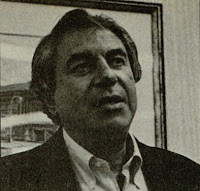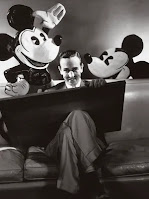This blog post is a part of the Hugo Book Club Blog’s cinema club, which has been working its way year by year through all the Hugo-finalist movies and television episodes.
In the early 1970s, NBC executive Paul L. Klein explained how the major networks created television programming. The then-dominant Big Three American networks (ABC, CBS, and NBC) believed that people didn’t watch specific programs, they watched television, and therefore the successful strategy was not to make high-quality shows, but rather to make the shows that would cause the fewest viewers to change the channel.
 |
| The L.O.P. model of entertainment incentivizes corporations to produce banal and derivative television series that provide little intellectual heft. (Image via TV Tropes) |
Viewers aren’t choosing the show they like, Klein said. They’re choosing to watch television, and selecting the least-objectionable option. It was a strategy that introduced television viewers to the evil of choosing among lessers, if you will.
He called this the “least-objectionable programming” (L.O.P.) theory, and it’s a view of mass media that dominated the television landscape for several decades (from roughly 1958 to 1992), and continues to inform the choices made by media executives.
As our cinema club has been working its way through Hugo-finalist television shows from the heyday of L.O.P., there’s often been uncomfortable parallels between the trends that led to Holmes & Yo Yo, and the direction that our present-day streaming services are going.
In fact, the legacy of L.O.P. can be seen today and is essential to understanding why certain shows get canceled, why others continue to be produced, and what to expect in the coming decades.
Many in the media have expressed confusion in the past week over Netflix’ decision to cancel German science fiction series 1899 after only eight episodes, despite generally positive critical reviews and reportedly high viewership numbers. The decision has been pointed to as emblematic of the streamer’s habit of canceling shows after only one season, and described as part of their growing graveyard of unfinished stories and a slash-and-burn approach to TV making.
Because it got out of the gate first, and therefore is the biggest player in the streaming landscape in terms of subscriber numbers, Netflix has an incentive first and foremost to keep people just engaged enough not to stop watching — which is a very different task than convincing people to sign up in the first place.
This incentive manifests itself as a focus on completion rates. What Netflix doesn’t want is a front-page show that people turn on, then decide they don’t want to watch anymore. The Midnight Club was one of the top shows on this streamer, racking up more than 90 million hours viewed when it debuted in October. The Mike Flanagan YA horror was praised by critics, but reportedly had a completion rate of just above 34 per cent, meaning that 65 per cent of viewers decided they had better things to do than watch the ending. The aim is to persuade people not to change the channel, which makes unobjectionable programming a top priority for Netflix.
L.O.P. is still alive and well at Netflix. This can be seen in their approach to colour grading and to cinematography. The streamer maintains a house style of editing that appears to be designed not to challenge viewers; there’s a flat and depthless feel based on their rigid rules for camera specifications. If you fall asleep watching the Netflix movie Adam Project, and wake up watching Red Notice, you might not notice that it’s a different movie. The cinematic language is always easy to parse: establishing shot followed by over-the-shoulder back and forths for dialogue. It’s all very comfortable, and makes it easy to go from one fungible Netflix Movie to the next without stopping between. This is a remarkably similar phenomenon to NBC’s TV shows of the 1970s, which recycled the same action beats, the same framing, and even the same typefaces. The L.O.P. model relies on fungibility. This makes a vast swath of Netflix content ideal for a demographic that doesn't care what they're watching.
This wasn’t always the case for Netflix; back when it was the scrappy upstart competing against legacy television, the streamer swung for the fences, took risks, and created some content of enduring value. But sometime around 2018 Netflix reinvented L.O.P. from first principles. And it makes sense for them in the short term; the financially comfortable court complacency when there’s a reward in stasis.
In the 1980s, the death grip that L.O.P. had on television networks started to be eroded by emerging technologies like pay-per-view and narrow-cast cable networks. Ironically, Paul L. Klein was instrumental in launching both. The Cambrian Explosion of television that followed produced new forms as well; the appointment viewing prestige channel; the direct marketing machine; the niche interest network. Each of these upended the assumptions of L.O.P., and the resulting market habitats can still be seen today.
 |
| From his cynical view of TV viewers, it should be no surprise that Paul L. Klein was also a racist purveyor of fascist porn. (Image via Twitter) |
Now, before we talk about how each streamer is different, we should note the obvious: Neither Netflix,nor Paramount+, nor Apple+, nor Amazon Prime, nor HBO Max is your friend. They are each appendages of multinational corporations whose agendas are only to make profit for shareholders. If any of these corporations could boost their margins by a fraction of a per cent by paying Hunter Moore and Andrew Tate to direct pornographic snuff films, they would do so without thinking twice.
The most obvious counterexample to the L.O.P. model of television is HBO, the pay network whose service model from 1992 onwards was to focus on a few anchor shows that drew in viewers. The content didn’t need to appeal to every viewer, and could be objectionable to many, as long as it was something that drew in a sufficient number of paid subscribers. We would wager that if they had launched on HBO Max in 2020, 1899 would have received a second season, while Emily In Paris would have been quickly forgotten. Until recently, the appointment viewing service model governed HBO’s approach to streaming, though with the chaos that has engulfed Warner Media over the past six months the approach they take now remains to be seen.
But the product differentiation that governed narrow-interest cable networks like SYFY, Legend, and Nick, is fundamentally different from both the L.O.P. or Appointment Viewing approach. Narrow-interest networks create products that are designed to check boxes; not necessarily to avoid offending, nor to cause water cooler conversations, but rather to fulfill a mandate. Obviously, Shudder and Crunchyroll are among the most prominent examples of this corporate entertainment paradigm in the streaming landscape of 2023.
There are two final models of streaming service to talk about, both of which are deeply problematic.
loss-leader. The television service doesn’t actually turn a profit, but rather incentivizes consumers to sign up to Amazon’s free shipping program and consequently (hopefully) order more from the online retailer. But more insidiously, the retail giant is able to create more and more accurate profiles of its streaming service users by recording the details of what they watch, how much they watch, and when they stop. We would suggest that one of the key reasons that Prime has shows geared to as wildly different political constituencies as The Boys and The Handmaid’s Tale is as part of a subtle psychological testing experiment. The Venn Diagram of people who watch Reacher and Ms. Maisel has little overlap; and now their algorithms know which data bucket you fall into.
The final model of streaming service may seem the most innocuous, but it’s the one that causes us the most concern: Identity as a subscription service. This model is typified by Disney+ and by Paramount+, and is fairly obvious in the ways in which they’ve built their content libraries around specific, organized media-franchise fandoms. There’s no ‘anchor show’ for either of these streamers, but rather an identity as a fan that one is subscribing to. It is difficult to be a “true Star Wars fan,” without paying an $11.99 monthly fee to Disney+ to be a part of that fandom. Likewise, it is difficult to be a “true Star Trek fan” without paying $9.99 to Paramount+ each month.
While individual shows on these services might come and go, these services are among the most likely to appear rational in their choices to an outside observer, and they are unlikely ever to abandon any of their cash-cow multimedia properties. Expect intellectually low-risk offerings that don’t rock the boat, and don’t threaten the long-term value of the IP owners or shareholders.
 |
| Noted anti-union activist Walt Disney has a problematic legacy of promoting patriarchy. (Image via USA Today) |
Self-identity as a key selling point of a subscription service may not seem like a problem, but it’s relatively easy to imagine a scenario in which a major streaming service leans into culture war divisions in an attempt to build a walled-garden identity streamer that appeals to the increasingly extreme right wing political identity. Given the company’s long history of encouraging heteronormativity and white supremacy, one would suspect that Disney+ is the likeliest streamer to follow the Fox News organizational radicalization highway. The consequences of this to the broader culture could be disastrous.
When discussing the purveyors of video entertainment, viewers and critics should always ask what each company is selling, how they are selling it, and to whom they are selling. The answers to these questions are vital for understanding the current media landscape, the future of streaming, and consequently the future of culture.



". Until recently, the appointment viewing service model governed HBO’s approach to streaming, though with the chaos that has engulfed Warner Media over the past six months the approach they take now remains to be seen."
ReplyDelete--Given the cancellation of Westworld, and its removal from HBO Max...I am not sanguine.
Westworld, Minx, Made For Love, Infinity Train...
DeleteI didn't love everything that HBO Max cancelled and removed from their back catalogue. But it really was mostly high-quality stuff that was at least ambitious.
Like, I really wasn't into Raised By Wolves at ALL. But I can't fault them for doing something weird and original there. I'd rather see a network that greenlights bizarre inexplicable messes like that, rather than relying on mind-numbing pablum like Emily In Paris.